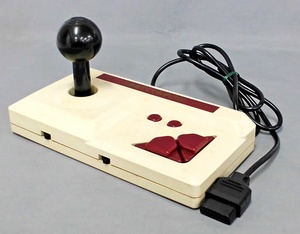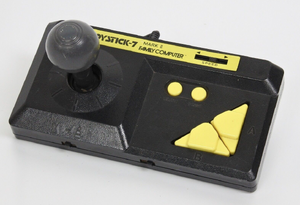Controller:HORI Joystick-7
 |
|
| XInput support | |
|---|---|
| Connection method | |
| Wired adapter |
The HORI Joystick-7 is an arcade game controller released by Hori in July 1985.
Made specifically for the Famicom, the Joystick-7 is the Hori's first arcade game controller. It has a 8-way digital joystick, 2 face buttons and 2 functional buttons. Located at the bottom side of the Joystick-7 is two toggle switches, one for changing the joystick settings between 4-way and 8-way, and the other one for switching between player 1 and player 2.
The upgraded model, the Joystick-7 Mark II, was released in March 1986. The Joystick Mk-II now has the turbo function with the speed rate up to 26.8 inputs-per-second.
Because they have the Famicom acccessory port., all Joystick-7 models requires a third-party adapter to be able to use on PC (See Adapters), and even then, they will acts as DirectInput devices, requiring the use of a third-party wrapper to play games that only support the XInput API.
Inputs
- 1 × digital joystick: ↑, ↓, ←, →
- 4 × digital face buttons: 𝐀, 𝐁
- 2 × digital functional buttons: sᴛᴀʀᴛ, sᴇʟᴇᴄᴛ
- 2 × 2-step slider toggle switches: 4-ᴡᴀʏ - 8-ᴡᴀʏ, I - II
- 1 × 3-step slider toggle switches (Only on Joystick-7 Mark II): ᴛᴜʀʙᴏ
Controller variations
- The Joystick-7 is the original release. It has the white body color with red-brown buttons.
- The Joystick-7 Mark II added the adjustable turbo function. It has the black body color with bright yellow buttons.
Use with PC platforms
Windows
| Supported features | reWASD | Steam | Gamepad Phoenix |
|---|---|---|---|
| Virtual Xbox controller emulation | ✓ [N 1] | ✓ | ✓ |
| Virtual Nintendo controller emulation | ✓ [N 2] | ✗ | ✗ |
| Multiple controllers | ✓ | ✓ | ✓ |
| Keyboard & Mouse input emulation | ✓ | ✓ | ✗ |
| Virtual DualShock emulation | ✓ [N 3] | ✗ | ✗ |
| Retro DInput/WinMM compatibility | ✗ | ✗ | ✓ |
- ↑ Allows using controller as Xbox 360 and Xbox One virtual controllers.
- ↑ Allows using controller as virtual Switch Pro Controller.
- ↑ Allows using controller as DualShock 3 and DualShock 4 virtual controllers.
reWASD
- Supports the Joystick-7 via a wired adapter, does not require manual driver installment.
- reWASD does not work with third-party drivers. Unsupported yet adapters have to be reported on official forum to implement their support.
- LED shows which config slot is active at the moment.
- Can emulate the DualShock 4 to play PS4 Remote Play, PS Now or Dualshock 4 compatible games. Including gyro and accelerometer control.
- Can emulate the Xbox 360 controller to play XInput-compatible games.
- Not free of charge. 14-days trial.
- Custom configs can be found in official Community Configs Library maintained by reWASD users.
XInput wrapping
- Being DirectInput controllers, it's possible to use any of the generic wrappers. See the controller article for those.
Steam
- With most adapters, Steam may recognize the Joystick-7 as a generic DirectInput device, thus requiring manual button mappings via Steam Input.
Hardware
Adapters
Raphnet Famicom controller to USB adapter (V2)
- Specialized Famicom-to-USB adapter.
- Adapter has updatable firmware, which can be updated via the Raphnet adapter management too
- Only act as a DirectInput device, requiring a third-party wrapper.[1]
Support in games
- Games with generic DirectInput support are supported by the controller, however button placements may be out of place and need to be rebound. Refer to game-specific articles for rebinding support.
- Support for some controller features may be only available on certain systems. Refer to game-specific articles for details.
Games with Nintendo button prompts
References
- ↑ Testing your adapter and controllers on Raphnet - last accessed on June 2023

